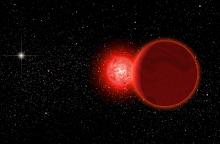Listen to today's episode of StarDate on the web the same day it airs in high-quality streaming audio without any extra ads or announcements. Choose a $8 one-month pass, or listen every day for a year for just $30.
You are here
Milky Way Center
If you look south shortly after sunset tonight, you’ll see eight moderately bright stars arranged in the shape of a teapot. That’s the constellation Sagittarius. It’s also where the center of our galaxy is — 27,000 light-years away. And this year marks the hundredth anniversary of the discovery that we’re far away from the Milky Way’s heart.
Early maps put us near the center, because dust in space obscures distant stars. As a result, we see only a small fraction of the Milky Way. And because of all the dust, we seem to be at the center of the little that we can see.
In the twentieth century, though, astronomer Harlow Shapley recognized the truth: that the galaxy is much bigger than had been thought, and that we’re off to one side.
Rather than mapping individual stars, Shapley looked at bright star clusters known as globulars. Most of these clusters are outside the Milky Way’s disk of stars, where the thickest dust resides, so dust doesn’t block our view of the clusters. And the clusters are quite bright, so we can see them even at large distances.
Shapley measured the distances to dozens of globular clusters. Some were so far away that, at first, he thought they were outside the Milky Way. But in 1917, he recognized that they not only belong to our galaxy, but they point the way to its center. That indicated that we don’t live in the Milky Way’s busy heart. Instead, we live in the suburbs of our galactic metropolis.
Script by Ken Croswell, Copyright 2017






